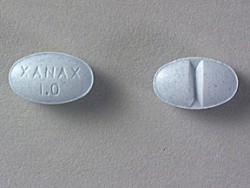What to Expect in Xanax Addiction Treatment
Xanax is a prescription benzodiazepine used to treat anxiety, acute anxiety, and panic attacks. Unfortunately, Xanax is highly addictive and can cause tremendous problems when you attempt to stop taking it. According to the National Institute on Drug Abuse, benzodiazepines should not be prescribed for long term use because of the addiction and withdrawal potential.
Xanax withdrawal is extremely dangerous and can cause serious health problems. This makes stopping very difficult without help. If you need to get away from your Xanax addiction, you might need to consider rehab, which can be frightening. So the questions is what can you expect during Xanax addiction treatment.
Xanax Withdrawal Symptoms

Xanax withdrawal can be incredibly difficult, involving insomnia, anxiety, and more.
Xanax has many withdrawal symptoms, some of these symptoms are relatively benign while others are considerably more dangerous. According to the National Library of Medicine, the withdrawal symptoms of Xanax are:
- anxiety,
- depression,
- convulsions,
- seizures,
- irritability,
- insomnia,
- headache,
- difficulty concentrating,
- muscle pain,
- nausea,
- panic attacks,
- irregular heartbeat,
- nightmares,
- suicidal ideation,
- psychosis,
- vomiting, and
- muscle pain and cramping.
This is just a small list of the Xanax withdrawal symptoms that you might experience if you quit Xanax cold turkey. Not getting treatment for these symptoms leads to relapse and continuing the cycle of addiction. Unfortunately relapse is not the only danger when you stop Xanax suddenly. These withdrawal symptoms can be dangerous and might require hospitalization.
Xanax Withdrawal Timeline
There are three basic stages of Xanax withdrawal. When you are in treatment, it helps to know what the symptoms are and how long they will last. Knowing them lets you know what to expect. These stages are:
- The acute phase – this stage is physical withdrawal. Your body is getting rid of the last Xanax in your system and your physical dependency on it. This is the most dangerous stage. What happens in this stage can kill you if it is not handled with medical attention.
o This starts around 12 hours after your last does of Xanax,
o It lasts between one to three months, most people are in treatment for three months,
o The symptoms subside easily if you are in a treatment program. Doctors can help you stop without experiencing the more negative symptoms of withdrawal.
o Quitting cold turkey can cause the adverse effects to linger longer.
- Protracted phase – this phase may last years. It is the lingering of withdrawal symptoms over a long time period. The symptoms that might linger are:
o insomnia,
o tremors,
o muscle twitches,
o tingling, and
o possible brain damage.
This phase also might require ongoing medical treatment to prevent the more adverse side effects. Many of these symptoms are very dangerous when experienced suddenly. Long term, extensive use of Xanax leads to permanent changes in the brain. These changes cause cognitive dysfunction if left unchecked.
- Recovery phase – in this phase most people completely recover from the use of Xanax. Unfortunately, this might take months or years to complete. Most of the time when someone decides to stop using Xanax a complete recovery is possible with medical attention. In this phase, it is important to treat your body properly and make sure that you are healthy.
It can take years to complete these stages; most people do make a full recovery as long as they stay away from the drug. Returning to Xanax use will make the next time you stop worse. When you choose to stop using Xanax, it is important to seek medical attention. Quitting cold turkey makes the withdrawal extremely dangerous. There are a few types of treatment available.
Inpatient Treatment
Inpatient treatment is highly recommended for those who are recovering from a Xanax addiction. In inpatient treatment, you stay at the treatment center 24 hours a day and have access to medication, counseling, and other types of treatment. Most people who start off with inpatient treatment do not suffer the serious adverse effects of withdrawal or Xanax detox.
While you are in the treatment center, you will be able to take advantage of:
- counseling,
- holistic therapies,
- medication,
- group therapy, and
- other onsite options.
When you are being treated, your day is planned around the events of the treatment center. You can usually choose to participate in the activities or just observe. You do not have to worry about outside concerns. Inpatient treatment can last anywhere from two weeks up to 90 days depending on the treatment center.
Outpatient Treatment
Outpatient treatment is another type of Xanax drug treatment. Instead of staying at the facility, you attend all of the same activities at a rehab center on an outpatient basis. This means you go to the facility either daily, weekly, or monthly to attend whichever sessions you and your doctor agree on.
In outpatient, treatment there is a wider range of treatment options. These treatment options are normally conducted on a regular basis to help you recover from your addiction. Doctors will examine you and provide whatever medication that you need to prevent withdrawal or the adverse effects of withdrawal.
Xanax withdrawal can be very dangerous if you decide to quit cold turkey. There is no reason that you have to go through the adverse effects. There is both inpatient and outpatient help available, all you have to do is call 888-646-0635Who Answers?.
